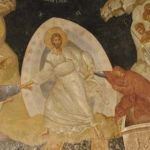THOMAS’ SUNDAY
Compiled by Seraphim Larin
It is not by chance that in continuing our celebration of Christ’s Resurrection, our Church has called the first Sunday after Easter – Thomas’ Sunday. The behaviour of this Apostle with regard to Christ’s Resurrection, carries great significance and profound meaning to each and every true Christian, for it deals with one of the devil’s deadliest lures – doubt! While our Church has many Mysteries that serve as Her foundations, which the flawed and limited human mind cannot comprehend, the Crucifixion and Resurrection of Christ is the most outstanding of all, perplexing and creating seeds of doubt in many people.
As we are aware, Evangelist John notes that when Christ first appeared to His Disciples after His Resurrection, Apostle Thomas was not among them. As can be seen from the Gospel, this Apostle was quite dogged in his convictions that sometimes devolved into obstinacy. This can be seen during Christ’s travel to resurrect Lazarus, when Thomas expressed his conviction that no good will come from such a journey: “Let us all go, that we may die with Him” (John 11:16). Again, when the Lord uttered His parting dialogue to the Apostles, repeating what He had told them on several occasions: “And where I go you know, and the way you know,” Thomas began to contradict: “Lord, we do not know where You are going, and how can we know the way? (John 14:5).
With such an obstinate attitude to life, Thomas couldn’t apply a judicious approach to Christ’s Crucifixion, and accepted this as being final and irreversible. He was completely crushed by the weight of his unalterable conviction that all was lost. All that he and his fellow Disciples had seen and learned from their Teacher was of no consequence. All that was left was for them to return to their homes and resume their independent lives they led before they were called by Christ.
While he wanted to believe in Christ’s Resurrection, his flawed physical powers of reasoning prevented him from even hoping that this miraculous event will take place. Crippled with doubt and steeped in misery, he didn’t even bother to be with his fellow Disciples when the Lord appeared to them, his reason being – “Why bother as everything is finished.”
Shortly after, he met the other Disciples who stated that “We have seen the Lord.” Although staggered by the news, his stubborn nature still guided his tongue as he responded that unless he saw this with his own eyes “and put my hand into His side” where the Roman spear entered, he would not believe.
After 8 days had elapsed since Christ’s appearance to the 10 Disciples, they all gathered (including Thomas) in the same house, when the Lord appeared among them. Looking at Thomas, the Lord directed him to look at His hands and place his hand into the side wound. The Evangelist doesn’t write as to whether Thomas did in fact physically do what the Lord told him to do. It would be a safe assumption to say that he did – and only then did the Disciple believe by exclaiming: “My Lord and my God!” It’s worth noting that the Lord is responding to Thomas’ doubt with his own words and stipulations by telling him to apply his designated demands in order to dispel doubt.
It is at this point that the real meaning of this occurrence becomes crystal clear, and can be found in Christ’ pronouncement: “Blessed are those who have not seen and yet have believed.” Thomas is an example of faith secured through physical proof. His flaw was in his nature that demanded stringent confirmations within his mind and its thinking processes. He couldn’t accept and believe the incomprehensible fact of Christ’s death and Resurrection. Consequently, in his desire to believe, his obdurate character demanded visible proof so that there would be no doubt in his mind and soul. His sincere desire to believe is established by Christ’s condescension by giving personal witness to Thomas’ doubts, as He never appeared in situations where there was evil and stubborn disbelief.
Having received this from Christ, his pent-up enormous belief emerged with profound words of “MY Lord and MY God”, and not a generalization: “Our Lord and Our God.” To him, Christ was his personal Lord and God, which he had now embraced with every fibre of his body and soul. At the same time, Christ’ words to Thomas underscores that a faith built on oral convictions (Gospel), is one that is a “blessed” faith. Those who have achieved such faith, which is more difficult than the way Thomas did because it is achieved on the basis of the word rather than a miracle, is worthy of Christ’s praise.
While Saint John concludes his narrative with the affirmation that “truly Jesus did many other signs in the presence of His Disciples, which are not written in this book”, he didn’t record any of those events. This is because he felt that what has been written by the four Evangelists was sufficient so “that you may believe that Jesus is the Christ, the Son of God, and that believing you may have life in His name.” As he points out that although relatively speaking little has been recorded, it is more than enough to prove and confirm the belief in Christ’s Divinity, and through such faith – receive hope and salvation.
In this current era of apostasy where falsehood and scepticism reigns supreme, unquestioning faith in our Lord and His unadulterated Teachings is continually under stress. Seeds of doubt are being spread by a myriad of religions and their false prophets, causing incalculable damage among those faithful that are strong in intentions but weak in resolve. Succumbing to their self-inflicted spiritual limitations, they allow this corrosive feeling to develop and grow within their hearts and minds, cultivated by the devils’ seductive whispers of freedom from the constraints of a stringent faith that requires self-control, spiritual deeds and concentration of belief. After all, a disbeliever’s hands are untied to commit many acts of lawlessness.
Consequently, this fateful event dealing with the resolution of Thomas’ doubt should be in the forefront of our minds, because it not only highlights the destructive strength of an unchecked doubt, but also underscores Christ’s blessing to those “who have not seen and yet have believed.”









